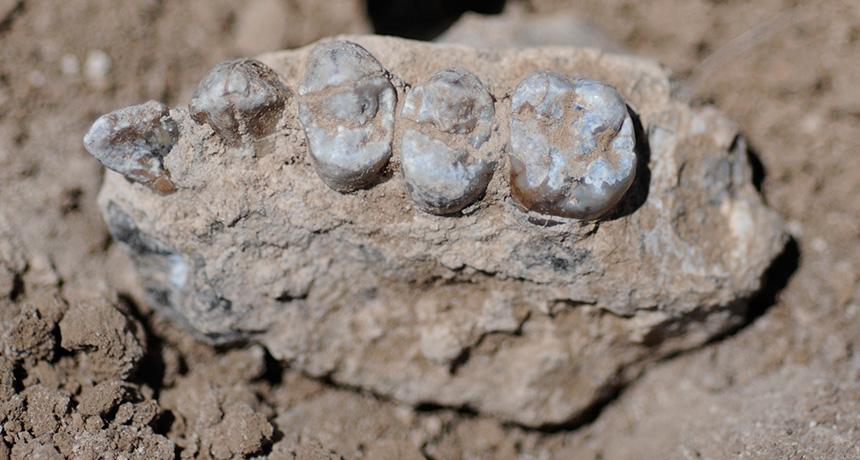Fossil find adds a relative to our family tree
化石研究帮我们寻找人类其他近亲
Scientists have discovered fossils of jawbones and teeth from what may be a new species on the human family tree. This distant human relative is long extinct. It lived between 3.3 million and 3.5 million years ago in what's now Ethiopia.
科学家从一种可能是人类的"近亲"的新物种上发现了下颚骨和牙齿化石,然而他们早已在地球上绝迹。存在现在的埃塞俄比亚,时间介于330万年至350万年前。
Scientists have named the new species Australopithecus deyiremeda. Researchers used a partial upper jaw and two lower jaws (one recovered in two pieces), to describe the species. (Deyiremeda means "close relative" in the local Afar language.)
科学家把这一新物种命名为Australopithecus deyiremeda(南猿近亲属),研究员利用一个上颌和两个下颌(下颌被发现时已是两半)来描述这一物种。(Australopithecus在当地阿尔法语言中意为"近亲属")
Yohannes Haile-Selassie of the Cleveland Museum of Natural History in Ohio and his colleagues shared details of their new find May 28 in Nature.
美国俄亥俄州克里兰夫自然历史博物馆研究员Yohannes Haile-Selassie和他的同事于5月28号在自然杂志中分享了他们的这一新发现的细节。
Paleoanthropologists like Haile-Selassie study ancient humans and their ancestors, based on fossils and cultural artifacts or symbols that they left behind. The new discovery suggests two or more species of ancient hominids coexisted in East Africa, Haile-Selassie says. (Hominids include humans and our fossil ancestors.) The new fossils were found near where another species of hominid lived at the same time. That species is best known by a partial skeleton nicknamed Lucy.
与Haile-Selassie一样的古人类学家利用化石,文化制品或者被遗留下来的文字符号来研究古人类以及他们的祖先,Haile-Selassie表示研究发现有两种或多种原始人类共同生存于非洲东部(原始人类包括人类和我们的祖先化石。)新化石发现于同时期另一个人类物种居住点附近。最著名的是一个昵称为Lucy的只剩部分骨骸的南方古猿。
Species tend to adapt and change - sometimes so much so that they morph into a new species. The emergence of new traits, as part of that adaptation, usually comes in response to changes in the environment, food supply or perhaps climate. "The $64 million question," says Haile-Selassie, "is 'What environmental and ecological factors triggered hominid species diversity between around 4 million and 3 million years ago?'"
物种倾向于适应和改变,有时候大量的变化最终导致他们干脆进化成一个全新物种。作为变化的一部分,那些新出现的特点通常会与周围环境,食物供应,或者气候等相协调。Haile-Selassie 指出"那个价值6400美元的问题就是‘约400万和300万年前导致原始人类物种多样性的环境和生态因素是什么’"?
